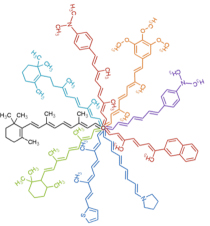News Archive
New approach to modifying functional properties of rhodopsin optogenetic tools
 December 2014. Since their discovery in 2003, rhodopsin optogenetic tools are widely used in neurobiology. Many variants of these proteins were introduced, all based on mutagenesis or engineering of the protein backbones. In a joint effort, the group of Jana Liewald and Alexander Gottschalk, together with Hegemann (Berlin), Fiala (Göttingen) and Trauner (Munich) have developed a novel approach to alter the functional properties of rhodopsin optogenetic tools, namely by modifications of the retinal chromophore. Synthetic retinal analogs were introduced into Channelrhodopsin-2 (ChR2) or other rhodopsin tools in C. elegans, Drosophila and human cells, to change the light sensitivity, photo cycle kinetics and color spectrum of the optogenetic actuators. The work is going to be published in Nature Communications on Monday, 15th December, 2014
December 2014. Since their discovery in 2003, rhodopsin optogenetic tools are widely used in neurobiology. Many variants of these proteins were introduced, all based on mutagenesis or engineering of the protein backbones. In a joint effort, the group of Jana Liewald and Alexander Gottschalk, together with Hegemann (Berlin), Fiala (Göttingen) and Trauner (Munich) have developed a novel approach to alter the functional properties of rhodopsin optogenetic tools, namely by modifications of the retinal chromophore. Synthetic retinal analogs were introduced into Channelrhodopsin-2 (ChR2) or other rhodopsin tools in C. elegans, Drosophila and human cells, to change the light sensitivity, photo cycle kinetics and color spectrum of the optogenetic actuators. The work is going to be published in Nature Communications on Monday, 15th December, 2014
N. AzimiHashemi, K. Erbguth, A. Vogt, T. Riemensperger, E. Rauch, D. Woodmansee, J. Nagpal, M. Brauner, M. Sheves, A. Fiala, L. Kattner, D. Trauner, P. Hegemann, A. Gottschalk & J. Liewald (2014) Synthetic retinal analogs modify the spectral and kinetic characteristics of microbial rhodopsin optogenetic tools. Nature Communications 5, article 5810. More ...
This work was funded by the European Union (EUTrigTreat), and the Deutsche Forschungs-gemeinschaft (SFB807 and Cluster of Excellence Frankfurt – Macromolecular Complexes).
Contact:
Alexander Gottschalk
Institute of Biochemistry
Buchmann Institute for Molecular Life Sciences
Goethe University Frankfurt
Riedberg Campus
Max von Laue Str. 15
60438 Frankfurt, Germany
a.gottschalk@em.uni-frankfurt.de

